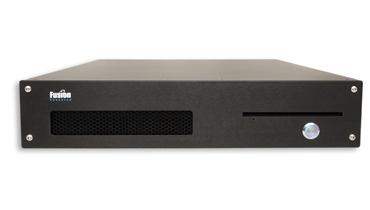Fusion Research Genesis media server and VR-VCP2 Cinema Player

| The Short Form |
| $10,990 (as tested) / FUSIONRD.COM / 925-217-1233 |
| Snapshot |
| A great-looking user interface and unlimited storage options distinguish this movie and music server |
| Plus |
| • Integrates with third-party network-attached storage • Interface displays high-rez cover art and is customizable per zone • Affordable compared with other options |
| Minus |
| • No simultaneous A/V output • Limited music-playback options |
| Key Features |
| • Genesis server's 1-terabyte drive holds 150 DVDs or 1,600 uncompressed CDs • Up to three Cinema Players can be connected to create four simultaneous A/V streams • Genesis ($7,995): Outputs: HDMI, DVI, VGA, component- and S-video; coaxial and optical digital and mini-jack analog audio; 3½ x 17 x 17¾ in; 25 lb • Cinema Player ($2,995): Outputs: HDMI, component video, and VGA; coaxial digital and RCA analog audio; 1¾ x 17 x 13 in; 12 lb |
While I love all A/V gear, media servers are really my thing, particularly ones that can handle both audio and video. There's just something so cool about having your entire movie and music collection available everywhere throughout the house, especially when you can stream multiple selections to different locations at the same time.
But ripping DVDs to a server is a sticky legal issue, and currently only three companies - Kaleidescape, AMX, and Fusion Research - have dared to wade into these sensitive waters. Fusion Research's Genesis (shown at top in photo) is the least expensive movie and music server available, but it combines features and performance that belie its price tag. The base Genesis system includes a 1-terabyte (TB) hard drive that can hold about 150 DVDs or 1,600 uncompressed CDs, and the Genesis can support up to three FR-VCP2 Cinema Players for a total of four simultaneous movie or music streams. With both the server and the Cinema Player getting a recent upgrade to 1080p, I wanted to see if Genesis was ready to serve.
SETUP
Like all streaming devices, the Genesis server and Cinema Players communicate over a computer network, meaning that the components connect to a router with Cat5 (or better) cabling. The system also taps the Internet to receive software updates and to look up movie and music metadata for the discs you load into it. Thanks to DHCP (Dynamic Host Configuration Protocol), once the server and player are attached to your home network and powered up, they automatically receive an IP address, "find" each other, and start communicating.
The system's default setup leaves its HDMI and digital-audio connections active, so I didn't need to reconfigure those settings. But only one set of audio and video outputs is active at a time, which means that you can't feed your home theater with the HDMI or digital-audio signal and simultaneously send analog audio and video to a house-wide A/V system. The system comes with an IR remote control and a USB receiver dongle. While Fusion has control interfaces for Crestron and AMX systems, Web browser control currently isn't possible, though the company expects to implement it.
With DVDs averaging around 6.5 GB each, it doesn't take long to fill up the base Genesis system's 1-TB hard drive. For an additional $995, Fusion offers a 2-TB version that you can use to either double the storage or have RAID protection against data loss. Fusion also offers lifetime unlimited storage ($4,995 for the 1-TB model, $3,995 for 2 TB), which lets you add even greater capacity to the Genesis by using relatively inexpensive network-attached storage (NAS) drives.
You can import DVDs and CDs into the Genesis using the slot-loading drive on the front panel. A CD begins transferring as soon as the disc is inserted, and it's ripped in about 3 to 4 minutes. (You can't play a CD without importing it first.) Fusion officially doesn't support CD-Rs, and of the five that I tried loading, only three could be imported - even though other servers, as well as iTunes on my PC, loaded them all.
For legal reasons, importing DVDs requires an extra step. You have to go to the cover-art menu, press the record button on the remote, and then highlight "Yes" to begin importing the disc. Having you click your acceptance puts the responsibility on you, the system owner, to import discs that belong to you.
A movie import - which includes the special features, all of the audio and subtitle tracks, and anything else on the disc - takes about 30 minutes and is ripped bit-for-bit with no compression. The system does let you play a DVD without importing it, although the video can't be streamed to a Cinema Player. You can also import home movies or video files in the MPEG, DivX, AVI, and Windows Media Video formats.
Fusion lets you customize its user interface on a per-zone basis, which is not only cool but extremely useful. Beyond just being able to change the colors and backgrounds to match the décor of a room, you can tweak the settings for the best experience in each zone. For instance, you could make things easier to read on smaller screens by displaying less information and using a larger type size.
- Log in or register to post comments
























































